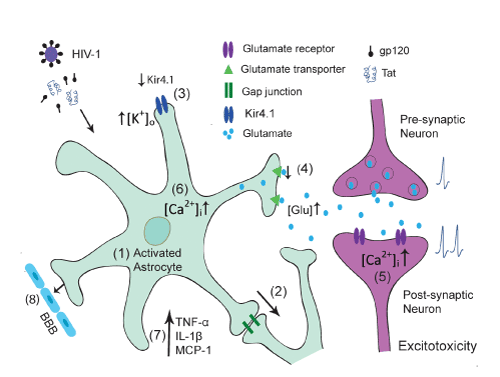
 |
| Figure 1: Schematic representation of astrocytic dysfunctions in HIV-1 neurotoxicity. (1) Astrocytes respond to HIV infection and viral proteins by rapid activation. (2) This response spreads and amplifies to surrounding astrocytes via gap junctions, which take part in modulating ATP release and glutamate and potassium homeostasis. (3) Reduced Kir4.1 expression and function impairs the ability of activated astrocytes to remove K+ in extracellular space and cause an increase in [K+]0, which would induce the depolarization of neuronal membranes and the interruption of axonal conduction and synaptic transmission. (4) Down regulation of glutamate expression and function results in glutamate excitotoxicity, which eventually may lead to neuronal injury and death. (5) This detrimental process is induced by overactivation of glutamate receptors located in neuronal membranes and causes an increase in intracellular Ca2+ levels, resulting in further injury. (6) Elevation of intracellular Ca2+ in astrocytes can also lead to increase in neuronal Ca2+, which may trigger excessive glutamate receptor activation and consequent excitotoxicity. (7) In addition, HIV-1 induced activated astrocytes secrete proimflammatory cytokines and chemokines, which may cause neuronal dysfunction or injury. (8) Reduced glutamate uptake, impaired potassium channel activity and elevated intracellular Ca2+ affect the BBB integrity and permeability resulting in increased penetration of HIV into the CNS. These alterations are likely acting synergistically to contribute to the accumulation of neurotoxicity and potentially play a role in HIV-1 induced neuropathogenesis. |